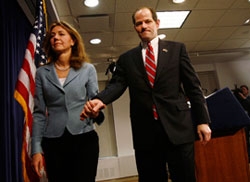
The most intriguing part of Alex Gibney’s new documentary, Client 9: The Rise and Fall of Eliot Spitzer, isn’t the conspiracy theories about who set up the former governor of New York, or the behind-the-scenes look at New York’s thriving escort industry; or even the details of Spitzer’s sexual peccadilloes (he comes across as pretty vanilla). Instead, it’s why Spitzer took such a monumentally stupid risk when he had so much to lose.
“There was a need to find a outlet,” Spitzer tells the camera toward the end of the movie, “that wasn’t within the very confined world in which I’d been living.”
It’s not that nuanced an answer. But that need to transgress does offer some insight into why so many powerful men (Jerry Springer, Barney Frank, David Vitter among them) sleep with prostitutes.
Spitzer, who collaborated with Gibney on the movie, told CNN that he thought it made more sense to participate and “present the facts as I saw them.” He isn’t coddled or whipped in the documentary. Instead, Gibney focuses more on the circumstances surrounding the crime than the crime itself, examining Spitzer’s career, the powerful enemies he made on Wall Street, and the people behind the escort service that led to his downfall.
“He was going to be our first Jewish president,” is how the movie introduces “Client 9,” who grew up in the Bronx and attended Princeton University and Harvard Law School. Spitzer recalls in the movie how he was exposed to the ruthless nature of business at an early age when his father foreclosed on him during a game of Monopoly.
Whether this sparked his vengeful public persona is uncertain, but he went on to become a corporate crusader as New York state attorney general, taking special aim at Wall Street excesses. His list of powerful targets includes Dick Grasso, former chairman of the New York Stock Exchange; Ken Langone, former director of the NYSE; and Hank Greenberg, former chairman and CEO of AIG. As a commentator in Client 9 puts it, “Eliot Spitzer had engaged an enemy with almost-unlimited resources.”
Gibney implies that this set of enemies found common cause with Spitzer’s political opponents. Spitzer clashed with New York Senate Majority Leader Joe Bruno, who like Grasso, Langone, Greenberg, and notorious political operative Roger Stone, also talks on-camera to Gibney. Stone alleges it was he who first tipped off the FBI about Spitzer’s use of prostitutes, from a chance sighting of Spitzer with a call girl in Florida (the FBI denies that it ever received such a letter).
Among the other questions Gibney raises: Why did the George W. Bush Department of Justice invest so much energy in busting a small prostitution ring when it was so focused on counter-terrorism? Why did the agents handling the investigation focus more on one of the Emperor’s Club clients than on the club itself? Was its intent to convict criminals or embarrass a client? Spitzer, to his credit, takes full responsibility for his actions and downfall, rather than using Gibney’s theory as an excuse.
Whatever the cause of Spitzer’s humiliation, it’s worth questioning the long-term impact of the sting. Spitzer confessed to a crime, resigned, spent a year or so quietly licking his wounds, and is now rehabilitating himself with a prime-time show on CNN. But Gibney’s thoughtful interviews with everyone from Greenberg, to 22-year-old madam Cecil Suwal to “Angelina”—Spitzer’s regular call girl—offer a side of the story that wasn’t immediately obvious at the time.
“It is to a certain extent, a very classic tale,” Spitzer says at the documentary’s opening. But beyond the headlines, Gibney suggests that the man who was once given a T-shirt saying “hubris is terminal” fell victim to more than just pride.
Subscribe to Washingtonian
Follow Washingtonian on Twitter
More>> After Hours Blog | Arts & Events | Happy Hour Finder | Calendar of Events
















